Did you know that bell peppers are not only delicious, but they are also packed with essential nutrients? These vibrant and versatile vegetables are a staple in many dishes, adding a burst of color and flavor. Whether you’re a seasoned gardener or just starting out, learning how to grow bell peppers can be a rewarding experience.
Key Takeaways:
- Choose the right bell pepper varieties based on your preferences and desired heat level.
- Transplant seedlings after the last frost and provide them with a sunny, well-drained spot.
- Ensure the soil pH is between 6.2 and 7.0 and incorporate compost for moisture retention.
- Monitor for pests and diseases, and take the necessary steps to control and prevent them.
- Harvest bell peppers when they are fully mature and store them properly for longer shelf life.
Choosing the Right Bell Pepper Varieties
When it comes to bell peppers, there is a wide range of varieties to choose from, each offering its unique flavor profile and level of heat. Whether you prefer sweet and colorful peppers or enjoy the fiery kick of hot peppers, selecting the right variety is essential for a successful and flavorful pepper-growing experience.
When choosing bell pepper varieties, it’s important to consider personal preference and the desired heat level. Some people enjoy the mild sweetness of traditional green bell peppers, while others prefer the vibrant flavors of red, orange, and yellow varieties. If you’re a fan of spicy foods, you may opt for hot pepper varieties such as jalapenos or habaneros.
To ensure success in your pepper-growing endeavor, it’s crucial to select strong and vigorous young plants from reputable sources. This ensures that you’re starting with healthy and disease-resistant plants that have a greater chance of thriving in your garden. Whether you’re purchasing seedlings from a local nursery or ordering seeds online, take the time to research and choose reliable sources.
When it comes to growing bell peppers, diversity is key. Experiment with different varieties to enjoy a range of flavors, colors, and heat levels. From traditional green bell peppers to exotic purple or chocolate-colored peppers, the options are endless. Growing different pepper varieties not only adds visual interest to your garden but also provides an exciting array of flavors for your culinary creations.
“Growing different pepper varieties can spice up your meals and add a burst of color to your garden.”
Popular Bell Pepper Varieties
| Variety | Color | Heat Level |
|---|---|---|
| Green Bell | Green | Mild |
| Red Bell | Red | Mild |
| Orange Bell | Orange | Mild |
| Yellow Bell | Yellow | Mild |
| Jalapeno | Green or Red | Medium |
| Habanero | Orange or Red | Hot |
Here are some popular bell pepper varieties to consider:
- Green Bell: The classic variety with a mild flavor.
- Red Bell: Ripe green bell peppers turn red and develop a sweeter taste.
- Orange Bell: Sweet and vibrant, perfect for adding color to dishes.
- Yellow Bell: Mild and crisp, great for salads and stir-fries.
- Jalapeno: A medium-heat pepper with a distinctive flavor, commonly used in Mexican cuisine.
- Habanero: One of the hottest peppers, known for its intense heat and fruity taste.
Remember, bell pepper varieties offer a range of flavors and heat levels, so be sure to choose the ones that best suit your taste buds and cooking style. Whether you’re adding a pop of color to your garden or spicing up your meals, growing different pepper varieties can elevate your bell pepper-growing experience.
Planting Bell Pepper Seedlings
Transplanting bell pepper seedlings is an essential step in successfully growing bell peppers. By providing the right conditions during planting, you can ensure that your pepper plants thrive and produce a bountiful harvest. Here are some key tips for planting bell pepper seedlings:
- Timing: Wait until after the last spring frost to transplant your bell pepper seedlings. This ensures that the risk of frost damage is minimal.
- Location: Choose a sunny spot in your garden for planting the bell pepper seedlings. Bell peppers require at least six to eight hours of direct sunlight daily to grow and ripen properly.
- Spacing: Space the seedlings 18 to 24 inches apart in the garden. This provides enough room for the plants to grow and allows for good air circulation, reducing the risk of disease.
- Soil Preparation: Incorporate compost or organic matter into the soil before planting. This improves soil fertility and drainage, creating an ideal growing environment for the bell pepper plants.
- Watering: After planting the seedlings, water them immediately to help settle the soil and establish the roots. Throughout the growing season, make sure to water the plants regularly to keep the soil consistently moist but not waterlogged.
- Support: As the bell pepper plants grow, they may need support to bear the weight of the fruit. Use stakes or small tomato cages to provide support and prevent the plants from bending or breaking under the weight of the peppers.
By following these planting guidelines, you can ensure that your bell pepper seedlings have a strong start and grow into healthy, productive plants.
Bell Pepper Plant Soil and Care
When it comes to caring for your bell pepper plants, proper soil conditions are essential for their health and productivity. Here are some important factors to consider:
- Sun and Drainage: Bell peppers thrive in sunny locations with well-drained soil. Ensure that your planting spot receives at least 6-8 hours of direct sunlight daily. Good drainage prevents waterlogged soil, which can lead to root rot and other problems.
- Container or Raised Beds: If you don’t have suitable garden soil, don’t worry! Bell peppers can be grown successfully in containers or raised beds filled with the right soil mix. This gives you more control over soil quality and drainage.
- Ideal soil pH: The ideal soil pH for bell peppers is between 6.2 and 7.0. Test your soil pH using a soil testing kit or consult with your local gardening center to ensure you have the right pH level for optimal plant growth.
- Organic Matter: Incorporating compost or aged compost-enriched soil into your planting area helps improve soil structure and fertility. It also helps retain moisture, which is crucial for good pepper production.
- Fertilization: To provide your bell pepper plants with the nutrients they need, it’s important to fertilize them properly. Use a continuous-release fertilizer or organic fertilizer formulated specifically for peppers. Follow the instructions on the package for application rates and timing.
- Regular Watering: Bell peppers require consistent moisture to thrive. Water your plants regularly, aiming for about 1-2 inches of water per week. Be careful not to overwater, as this can lead to fungal diseases.
- Mulching: Mulching around your bell pepper plants can help keep the soil cool, retain moisture, and suppress weed growth. Use organic mulch like straw, shredded leaves, or grass clippings, and spread it around the base of the plants.
“Proper soil conditions are crucial for the health and productivity of bell pepper plants. With the right care and attention to soil requirements, you can ensure a bountiful harvest of delicious peppers.”
Troubleshooting Pepper Plant Problems
While bell peppers generally have few serious pest problems, it’s important to be aware of potential issues that may arise during the growing season. Taking prompt action can help protect your plants and ensure a successful harvest.
Pests of Bell Pepper Plants
One common pest that can affect bell peppers is aphids. These small insects can transmit viruses to your plants, leading to stunted growth and reduced yields. To prevent aphids from infesting your peppers, regularly inspect your plants and remove any affected leaves or stems. You can also introduce beneficial insects like ladybugs or lacewings that feed on aphids.
Common Pepper Plant Problems
Another potential problem you may encounter is root-knot nematodes. These microscopic worms can cause the roots of your pepper plants to become swollen and knotted, leading to nutrient deficiencies and poor growth. To prevent root-knot nematodes, ensure proper soil drainage and avoid overwatering your plants. Additionally, consider planting nematode-resistant varieties.
Late spring cold spells can also pose a threat to your pepper plants. Cold temperatures can damage the plants and inhibit growth. If you’re expecting a frost or frost-like conditions, it’s recommended to cover your plants with a protective fabric or plastic sheeting. This will help retain warmth and shield the plants from cold damage.
The Pepper’s Journey to Maturation
Finally, it’s important to note that the color of bell peppers may take time to change as they ripen. While green bell peppers are commonly harvested and enjoyed, other colors such as red, yellow, and orange indicate full ripeness. The flavor of the pepper will develop fully regardless of the color. So be patient and allow your peppers to reach their optimal maturity before harvesting.
By being vigilant and proactive in addressing common pepper plant problems, you can ensure the health and productivity of your bell pepper plants.
Harvesting and Storing Bell Peppers
When it comes to enjoying the fresh flavors of bell peppers, proper harvesting and storing techniques are essential. By following a few simple steps, you can ensure that your bell peppers maintain their taste, texture, and nutritional value for longer periods.
Harvesting Bell Peppers
To harvest bell peppers, use pruning shears or a knife to cut the peppers from the plant. Be sure to leave a short stub of stem attached to the pepper, as this helps to preserve the freshness and prevent rotting.
When determining the right time to harvest bell peppers, look for the following signs:
- Firm texture and glossy appearance
- Full size based on the variety you’re growing
- Mature color (green, red, yellow, or other depending on the variety)
Remember, the longer bell peppers stay on the plant, the sweeter and more flavorful they become. However, if you harvest them early, the peppers will have a milder taste.
Storing Bell Peppers
After harvesting bell peppers, rinse them gently to remove any dirt or debris. Then, it’s time to store them properly to prolong their freshness.
The best way to store bell peppers is to place them in a perforated plastic bag and store them in the refrigerator. The perforations allow air circulation while preventing excessive moisture, which can lead to spoilage. Storing bell peppers in the crisper drawer can help maintain their crispness.
If you have unripe bell peppers, you can ripen them indoors by placing them at room temperature. They will continue to ripen for up to three days. However, it’s essential to monitor them closely and use them as soon as they reach the desired ripeness.
Timing Your Harvest
Knowing when to harvest bell peppers is crucial for getting the best flavor and quality. Here are some guidelines:
- Harvest bell peppers when they reach full size and have vibrant colors.
- Avoid leaving mature peppers on the plant too long, as they may become overripe, lose their firmness, and develop a bitter taste.
- It’s best to harvest all peppers before the first fall frost to prevent damage.
By following these tips, you can enjoy the delightful taste of freshly harvested bell peppers that you grew with care.
Handling Hot Peppers
When it comes to handling hot peppers, it’s important to exercise caution and follow safety tips to avoid any discomfort or injuries. Hot peppers contain capsaicin, which is responsible for the heat they produce. Here are some important safety measures to keep in mind:
- Wear gloves: If you have sensitive skin or are handling extremely hot peppers, it’s advisable to wear gloves to protect your hands from direct contact with capsaicin.
- Avoid touching your face or eyes: Capsaicin can cause a burning sensation if it comes into contact with your face or eyes. Be sure to wash your hands thoroughly after handling hot peppers and avoid touching your face until you do so.
- Rinse with cold water: If capsaicin gets on your skin or in your eyes, immediately rinse the affected area with cold water. This will help alleviate the burning sensation.
- Clean surfaces and utensils: After preparing hot peppers, it’s important to wash all surfaces and utensils thoroughly to remove any remaining capsaicin and prevent its spread to other foods.
By following these safety tips, you can handle hot peppers with confidence and enjoy their spicy flavors without any worries.
Quote:
“When handling hot peppers, it’s essential to take safety precautions to avoid any discomfort or accidents. By wearing gloves, avoiding contact with your face or eyes, and thoroughly cleaning all surfaces and utensils, you can handle hot peppers safely.” – Expert Gardener
| Safety Tips for Handling Hot Peppers |
|---|
| Wear gloves to protect your hands from capsaicin. |
| Avoid touching your face or eyes while handling hot peppers. |
| Rinse with cold water if capsaicin gets on your skin or in your eyes. |
| Thoroughly clean surfaces and utensils used to prepare hot peppers. |
Growing Bell Peppers in Different Colors
Bell peppers come in a variety of colors, including red, purple, orange, yellow, and green. Growing different colored bell peppers adds visual interest to the garden and meals. Colored bell peppers can be added to salads, stir-fries, and sandwiches.
| Color | Description |
|---|---|
| Red | Rich, sweet, and fully matured flavor. Great for roasting and adding to sauces. |
| Purple | Elegant and slightly spicy. Adds vibrant color to dishes and works well in stuffed recipes. |
| Orange | Sweet and juicy with a hint of citrus. Perfect for fresh eating and adding to salsas. |
| Yellow | Mild and sweet flavor. Adds a pop of brightness to salads and stir-fries. |
| Green | Crunchy and mildly bitter when unripe. Commonly used in traditional dishes. |
Experimenting with different colored bell peppers not only adds variety to your meals but also provides an opportunity to explore different flavors and textures. Whether you’re growing them in a garden or in containers, these colorful peppers will make a delightful addition to your culinary adventures.
Planting Bell Peppers with Proper Technique
When it comes to planting bell peppers, proper technique is key to ensuring healthy and productive plants. By following a few tips, you can set your pepper plants up for success.
Firstly, it’s important to prepare the soil before planting. Start by incorporating compost and organic matter into the soil to enhance nutrient content and improve drainage. This will create a favorable environment for your bell pepper plants to thrive.
Tip: Arranging different colored pepper plants in an alternating pattern can not only add visual appeal to your garden but also make it easier to identify and harvest peppers of different varieties.
When it’s time to plant your bell peppers, dig a hole as deep as the container the transplant is in. Ensure that the soil line of the transplant is level with the garden soil. This will prevent water from pooling around the stem, reducing the risk of rot and other plant diseases.
Once the plants are in the ground, give them a good watering to settle the soil and provide immediate hydration to the roots. Remember to water regularly, especially in dry weather, to keep the soil consistently moist but not waterlogged.
Proper Plant Spacing
Proper spacing is crucial for bell pepper plants to grow and develop fully. Be sure to space your pepper plants at least 18 to 24 inches apart. This allows for adequate air circulation and prevents overcrowding, which can lead to increased susceptibility to pests and diseases.
To help support the plants as they grow and bear fruit, consider adding stakes or small tomato cages. This will prevent the plants from drooping or bending under the weight of the peppers, ensuring a more productive harvest.
Maintaining Care and Watering
After planting, it’s important to continue providing regular care and watering until the plants are fully established. This will help the roots develop and ensure strong, healthy growth.
Here are some additional tips to ensure optimal growth:
- Apply a layer of mulch around the plants to help conserve moisture, suppress weeds, and regulate soil temperature.
- Monitor the soil moisture regularly and water deeply whenever the top inch of soil feels dry.
- Fertilize the plants with a balanced fertilizer according to the manufacturer’s instructions to provide essential nutrients.
- Inspect the plants regularly for signs of pests or diseases, and address any issues promptly to prevent further damage.
Incorporating these techniques into your bell pepper planting process will give your plants a strong start and set them up for a successful growing season.
Bell Pepper Pest and Disease Control
When it comes to growing bell peppers, keeping them free from pests and diseases is crucial for a successful harvest. Common pests that can wreak havoc on bell pepper plants include spider mites and aphids. Spider mites thrive in hot, dry weather, while aphids can be found on various parts of the plant.
To prevent pest infestations, it’s important to regularly inspect your plants. If you notice any signs of spider mites or aphids, take immediate action. One effective method is mist-spraying affected areas with a gentle stream of water. This can help discourage pests and keep them at bay.
“Regularly mist-spray affected areas to discourage pests.”
In addition to pests, bell pepper plants can also be susceptible to diseases such as anthracnose and bacterial leaf spot. These diseases can cause significant damage to the plants and affect the quality of the peppers. However, there are steps you can take to prevent these diseases from taking hold.
Choosing resistant varieties is one of the best ways to prevent diseases in your bell pepper plants. Look for varieties that have been specifically bred to be resistant to common diseases. Additionally, providing good drainage for your plants is essential as it helps prevent waterlogged soil, which can contribute to disease development.
By taking proactive measures to control pests and prevent diseases, you can ensure that your bell pepper plants remain healthy and productive throughout the growing season.
Disease-Resistant Bell Pepper Varieties
| Variety | Resistance |
|---|---|
| King Arthur | Anthracnose, Bacterial Leaf Spot |
| Gypsy | Anthracnose, Bacterial Leaf Spot |
| Revolution | Anthracnose, Bacterial Leaf Spot |
Table: Disease-resistant bell pepper varieties
Bell Pepper Pest and Disease Chart
Proper identification and action are crucial to maintaining the health of bell pepper plants. This chart provides a detailed overview of the common pests and diseases that can affect bell peppers, along with their symptoms, control measures, and prevention techniques.
| Pest or Disease | Symptoms | Control Measures | Prevention Techniques |
|---|---|---|---|
| Bell Pepper Pest 1 | Symptoms of pest 1 in bell peppers | Control measures for pest 1 | Prevention techniques for pest 1 |
| Bell Pepper Pest 2 | Symptoms of pest 2 in bell peppers | Control measures for pest 2 | Prevention techniques for pest 2 |
| Bell Pepper Disease 1 | Symptoms of disease 1 in bell peppers | Control measures for disease 1 | Prevention techniques for disease 1 |
| Bell Pepper Disease 2 | Symptoms of disease 2 in bell peppers | Control measures for disease 2 | Prevention techniques for disease 2 |
By referring to this comprehensive chart, you can quickly identify and address any issues that may arise with your bell pepper plants. Taking proactive measures to control pests and prevent diseases will ensure the continued health and productivity of your bell peppers.
Conclusion
Growing bell peppers can be a rewarding experience that leads to a bountiful harvest of delicious peppers. By following a few simple tips, you can ensure the success of your bell pepper plants and enjoy the flavors of fresh peppers throughout the season.
First, it’s important to choose the right varieties of bell peppers. Consider your personal preferences and desired heat level when selecting your plants. Look for strong and healthy seedlings from reputable sources to give your plants the best start.
Next, proper planting and care are essential for the growth of your bell pepper plants. Ensure they are planted in a sunny, well-drained spot with enough space for each plant to thrive. Incorporate compost or organic matter into the soil to provide the necessary nutrients for healthy growth. Regular watering and the use of stakes or tomato cages for support will help your pepper plants flourish.
Lastly, address any pest and disease issues that may arise. Keep an eye out for common pests like aphids and spider mites, and promptly treat any infestations. Choose resistant varieties and provide good drainage to minimize the risk of diseases. By taking these precautions, you can safeguard the health of your bell pepper plants and maximize your harvest.
With proper handling and storage, you can enjoy the flavors of fresh bell peppers throughout the season. Cut peppers from the plant with pruning shears or a knife, leaving a short stub of stem attached. Rinse harvested peppers and store them in the refrigerator. Unripe peppers can ripen indoors for a few days before enjoying them in your favorite recipes. The journey of growing bell peppers is one that offers both satisfaction and delicious rewards!

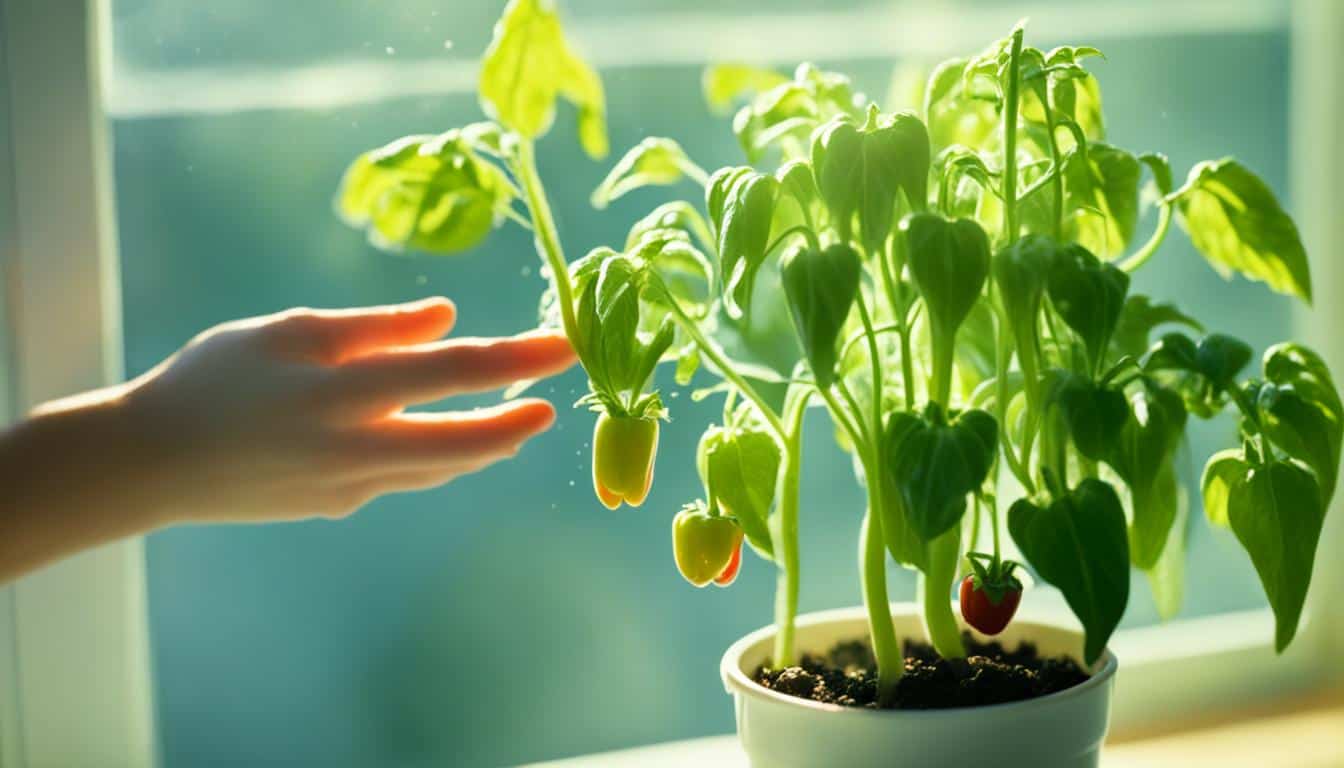
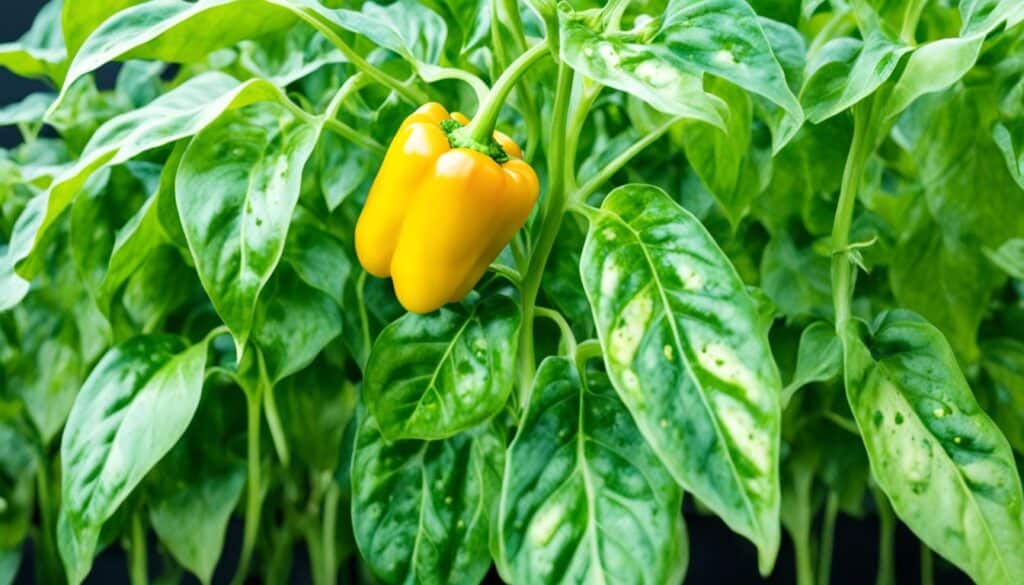
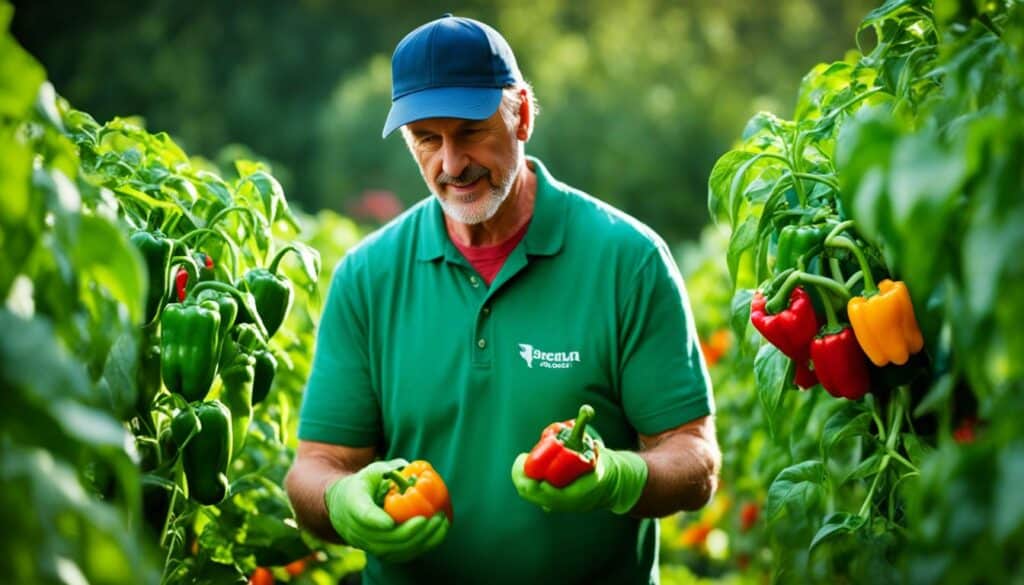
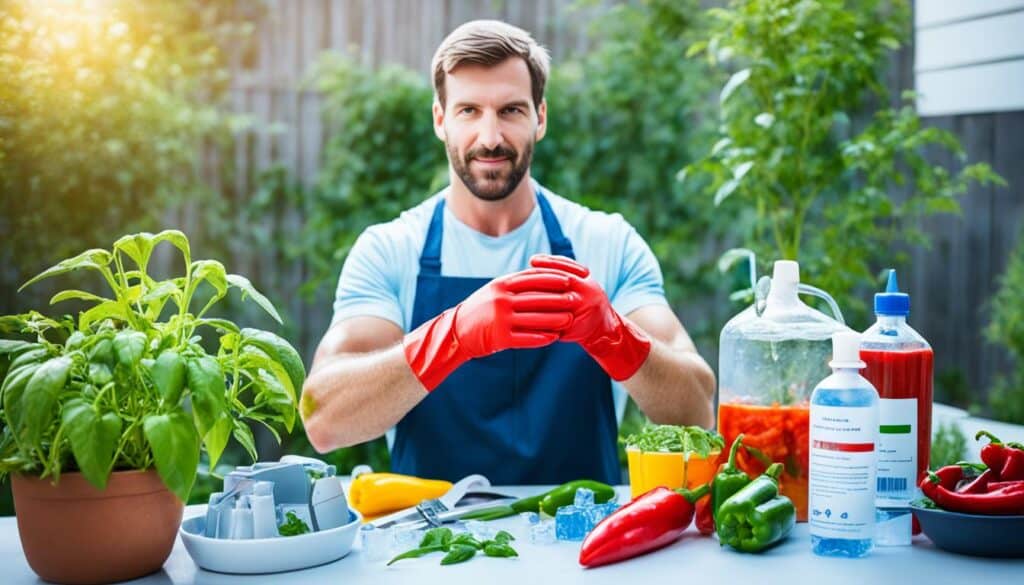
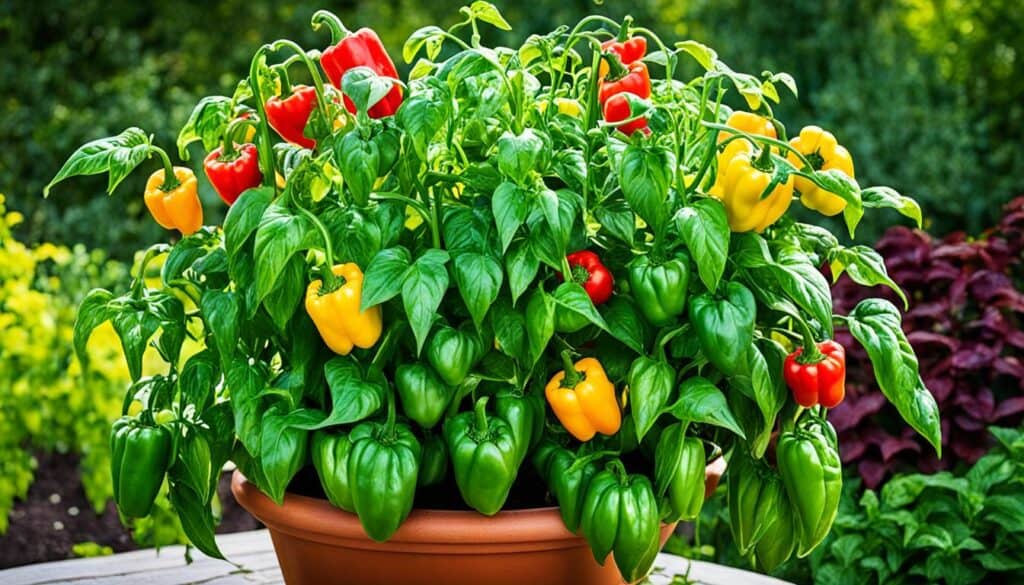
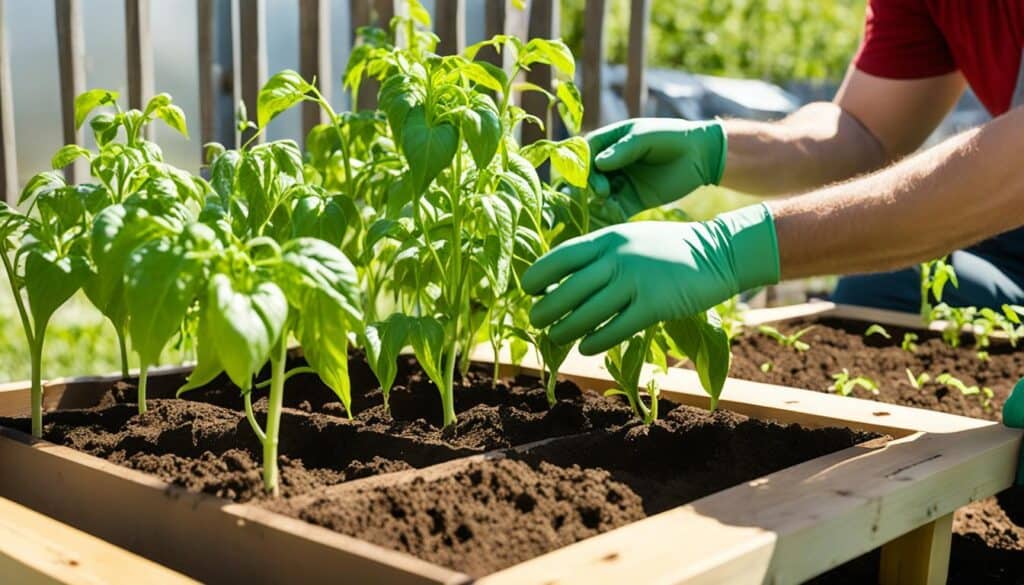



Leave a Reply